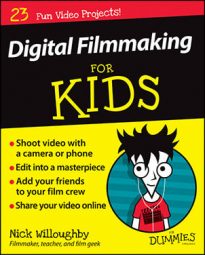Coming up with an idea can be one of the hardest parts of filmmaking, but it can be the most exciting, too. When thinking about making a film trailer, it’s important to decide on the genre of your film. What is a genre? A genre is the type, style, or category of film.
The following list describes most of the main film genres:
Action: Usually a big-budget film that uses high energy, excitement, stunts, chases, explosions, fights, and larger‐than‐life heroes to tell the story. Examples of action films include The Maze Runner, Jurassic World, and The Dark Knight Rises.
Animated: A film made from a series of illustrations or drawings to tell the story. Actors’ voices are recorded separately for the animated characters’ voices. Examples of animated movies include Frozen, Despicable Me, and the Toy Story films.
Adventure: An adventure film is similar to an action film, but it focuses more on an exciting story than on stunts and explosions. Adventure films often involve a journey. Example of adventure movies include the Hobbit and Lord of the Rings films, and The Hunger Games.
Comedy: A film intended to make the audience laugh. Comedies are not easy to write, but they can be great fun to make. Examples of comedy films include The Lego Movie, Diary of a Wimpy Kid, and Night at the Museum.
Crime: A film involving a crime, usually following the life of a criminal or gangster. Examples of crime films include The Dark Knight and the Fast and Furious movies.
Drama: A film that focuses on a story and the characters within that story in order to take the audience on an emotional journey. Examples of drama films include The Theory of Everything, Titanic, and Forrest Gump.
Fantasy: A film about magic, myths, legends, and fairy‐tales that takes place in a fantasy world. Examples of fantasy films include Into the Woods, Maleficent, and the Harry Potter films.
Historical: A film involving history or that re‐creates a historical event. This can include biblical, medieval, or wartime events, among others. Examples of historical films include Saving Mr. Banks, Lincoln, and Amazing Grace.
Horror: A film designed to frighten or shock the audience. Many horror films include monsters, ghosts, vampires, and zombies, often with exaggerated violence and gore. Examples of horror films include Dracula Untold and the Woman in Black films.
Musicals: A film that uses music, songs, and occasionally dance to tell the story. Examples of musicals include Annie, Grease, and Hairspray.
Romance: A film with a story about a love relationship between two characters. Romance films aim to create strong emotions from the audience. Examples of romance films include The Notebook, Gone with the Wind, and The Fault in Our Stars.
Science fiction: A film that involves futuristic technology, aliens, monsters, heroes, space, and things from other worlds. Examples of science fiction films include Interstellar, Star Wars, and Avatar.
War: A film that uses battlefields, fighting, and war to tell the story. Usually these films are based on true events. Examples of war films include The Imitation Game, War Horse, and The Boy in the Striped Pajamas.
Westerns: A film taking place in the American Old West in the late 1800s, usually involving involves horses, gun fighting, cowboys, and Indians. Examples of western films include The Lone Ranger, Dances with Wolves, and the Young Guns films.
Using a film genre helps the audience understand what to expect from a film. People usually do a bit of research into a film before going to see it, and when a trailer shows that a film is in a genre they find appealing, it may help them make up their minds. Most films have more than one genre and fit into more than one category. These include romantic‐comedies, action‐thrillers, action‐comedies, crime‐thrillers, and many more.
Have a look through the films on your DVD shelf and see which ones fit into the genres above.
When you have decided on a genre for your film, you need to think about what your story is about. Here are a few things to think about when coming up with an idea:
What your audience wants: It’s important to consider your audience: Who are they? What do they want? Don’t just come up with ideas that you want to do or that you think will work. Ask your audience — that is, ask people you know who watch your sort of film what they would like to see. Someone may give you the start of an idea that you could develop into a story.
There’s a story out there: Many films are based on true stories or events. Perhaps you or someone you know has a story on which you can base your film. Ask around, and see what stories you can find. If you can’t find a story from people you know, look through a few short story anthologies; the stories there may inspire you.
What is possible: Coming up with film ideas about aliens, monsters, and far away planets can be good if you own a spaceship, but you’d do better to consider the sorts of stories you can film with the locations and props you already have around you. For inspiration, have a look around and see what’s available to you.
No idea is a bad idea: Write down every idea you have because there is no such thing as a bad idea at this point of the filmmaking process. Any idea you think is bad could easily develop into something great. You may end up writing down loads of ideas you won’t use for a while, but it never hurts to have more ideas than you need. Any idea that’s useless for your current project could well inspire your next story.

